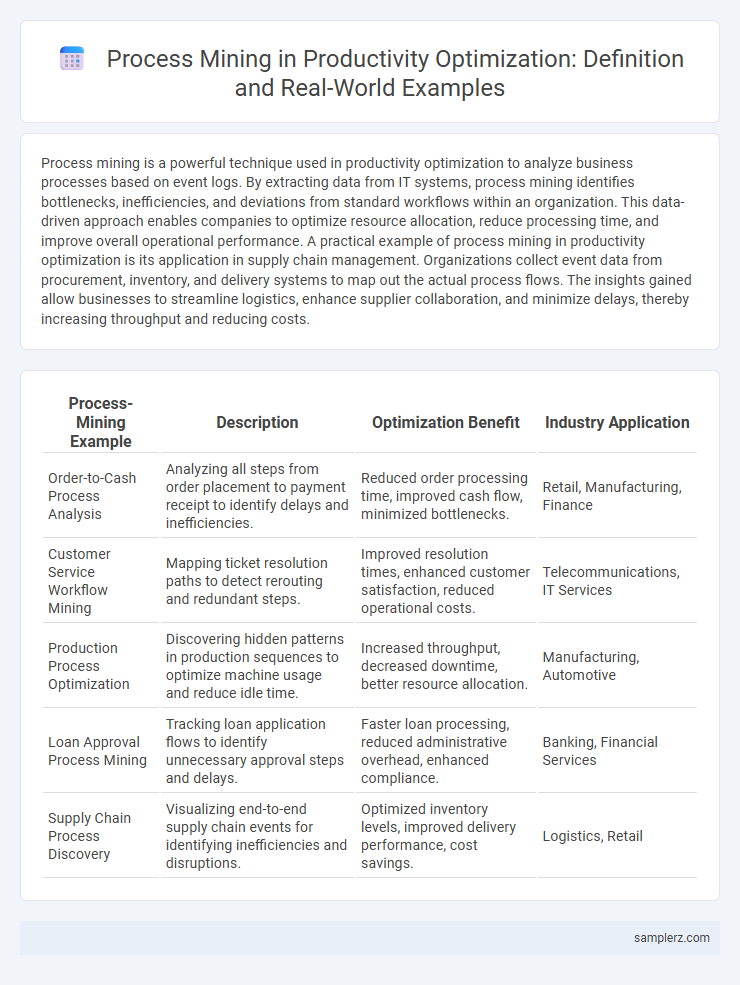Process mining is a powerful technique used in productivity optimization to analyze business processes based on event logs. By extracting data from IT systems, process mining identifies bottlenecks, inefficiencies, and deviations from standard workflows within an organization. This data-driven approach enables companies to optimize resource allocation, reduce processing time, and improve overall operational performance. A practical example of process mining in productivity optimization is its application in supply chain management. Organizations collect event data from procurement, inventory, and delivery systems to map out the actual process flows. The insights gained allow businesses to streamline logistics, enhance supplier collaboration, and minimize delays, thereby increasing throughput and reducing costs.
Table of Comparison
| Process-Mining Example | Description | Optimization Benefit | Industry Application |
|---|---|---|---|
| Order-to-Cash Process Analysis | Analyzing all steps from order placement to payment receipt to identify delays and inefficiencies. | Reduced order processing time, improved cash flow, minimized bottlenecks. | Retail, Manufacturing, Finance |
| Customer Service Workflow Mining | Mapping ticket resolution paths to detect rerouting and redundant steps. | Improved resolution times, enhanced customer satisfaction, reduced operational costs. | Telecommunications, IT Services |
| Production Process Optimization | Discovering hidden patterns in production sequences to optimize machine usage and reduce idle time. | Increased throughput, decreased downtime, better resource allocation. | Manufacturing, Automotive |
| Loan Approval Process Mining | Tracking loan application flows to identify unnecessary approval steps and delays. | Faster loan processing, reduced administrative overhead, enhanced compliance. | Banking, Financial Services |
| Supply Chain Process Discovery | Visualizing end-to-end supply chain events for identifying inefficiencies and disruptions. | Optimized inventory levels, improved delivery performance, cost savings. | Logistics, Retail |
Introduction to Process Mining in Workflow Optimization
Process mining leverages event logs from IT systems to visualize, analyze, and optimize workflows by identifying bottlenecks and inefficiencies. Algorithms extract actionable insights from data patterns, enabling organizations to streamline operations and enhance productivity. Integrating process mining into workflow management leads to data-driven decision-making and continuous process improvement.
Key Benefits of Applying Process Mining for Productivity
Process mining leverages real-time data analysis to identify inefficiencies and bottlenecks within workflows, enabling precise optimization of business processes. Enhanced transparency through process mining fosters data-driven decisions that improve resource allocation and reduce operational costs. Organizations applying process mining report significant productivity gains, including faster cycle times and increased throughput.
Real-World Case Study: Process Mining in Manufacturing
Process mining in manufacturing leverages real-time data from production systems to uncover inefficiencies and bottlenecks, significantly enhancing throughput and reducing downtime. A notable case study at Siemens used process mining techniques to optimize its assembly line, resulting in a 20% increase in operational efficiency and a 15% reduction in cycle time. By analyzing event logs, Siemens identified key process deviations and implemented targeted automation, driving substantial productivity gains.
Optimizing Supply Chain Efficiency Using Process Mining
Process mining analyzes event logs from supply chain systems to identify bottlenecks, inefficiencies, and deviations in workflows. By uncovering hidden patterns and process variations, companies can streamline order fulfillment, reduce lead times, and enhance inventory management. Implementing process mining tools leads to data-driven decisions that optimize end-to-end supply chain operations and improve overall productivity.
Enhancing Customer Service Operations Through Process Mining
Process mining technology uncovers inefficiencies in customer service workflows by analyzing event logs from CRM systems, enabling businesses to identify bottlenecks and streamline ticket resolution processes. By mapping actual customer interactions, companies can optimize response times and improve agent performance, leading to higher customer satisfaction rates. Implementing process mining tools has proven to reduce average handling time by up to 30%, directly enhancing operational productivity in call centers.
Process Mining in Financial Transaction Optimization
Process mining uncovers inefficiencies in financial transaction workflows by analyzing event logs from payment systems, enabling organizations to identify delays, bottlenecks, and compliance issues. By visualizing transaction paths and comparing them against ideal processes, companies optimize approval times and reduce reconciliation errors, enhancing overall cash flow management. Integrating process mining tools with ERP and blockchain platforms supports real-time monitoring and continuous improvement of financial processes.
Improving Healthcare Process Flows via Process Mining
Process mining enhances healthcare productivity by analyzing event logs to identify bottlenecks and inefficiencies in patient flow, treatment protocols, and administrative tasks. Hospitals implementing process mining have reduced patient wait times by up to 30% and optimized resource allocation, leading to improved care delivery and reduced operational costs. Real-time insights from process mining tools enable continuous improvement in clinical workflows, ensuring higher patient satisfaction and better health outcomes.
Reducing Bottlenecks in IT Services with Process Mining
Process mining identifies bottlenecks in IT service workflows by analyzing event logs and visualizing process inefficiencies. By detecting repetitive delays and resource constraints, organizations can streamline task allocation and improve service response times. Deploying process mining tools leads to enhanced IT service performance and reduced downtime, optimizing overall productivity.
Streamlining Human Resources Processes Using Process Mining
Process mining streamlines human resources processes by analyzing event logs to identify bottlenecks in recruitment, onboarding, and employee performance evaluations. Companies achieve significant productivity gains by automating repetitive HR tasks and optimizing workflow paths. Enhanced data-driven insights facilitate quicker decision-making, reducing cycle time and increasing employee satisfaction.
Measuring Productivity Gains from Process Mining Solutions
Process mining solutions enable organizations to analyze event logs and identify inefficiencies in workflows, directly quantifying productivity gains by revealing bottlenecks and redundant tasks. By leveraging process mining data, companies can measure key performance indicators (KPIs) such as cycle time reduction, throughput increase, and resource utilization, providing concrete metrics of improvement. Real-world implementations show productivity gains up to 30% through optimized process automation and targeted resource allocation driven by granular insights from process mining tools.

example of process-mining in optimization Infographic
 samplerz.com
samplerz.com